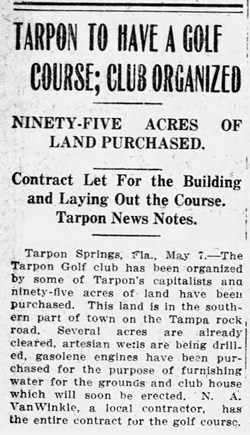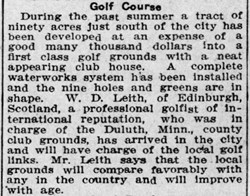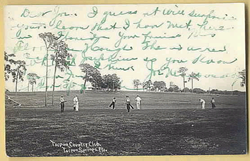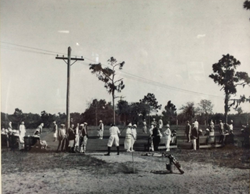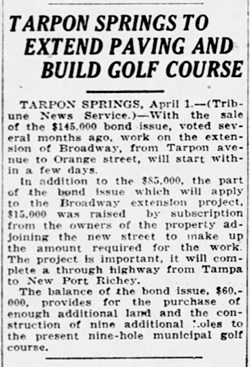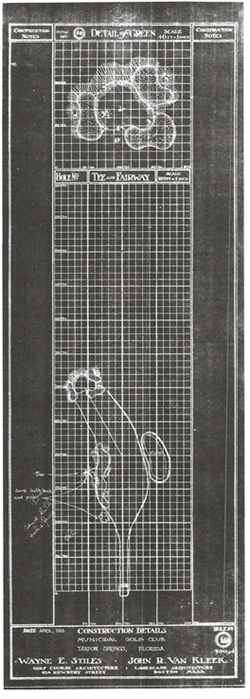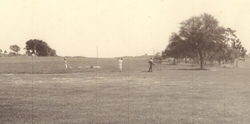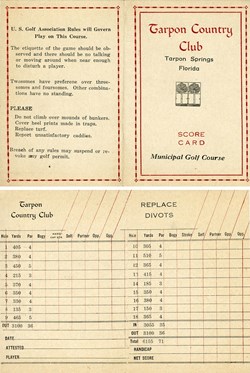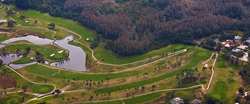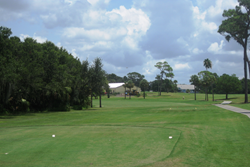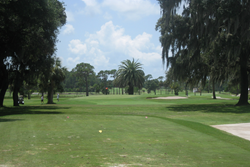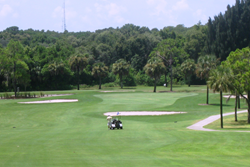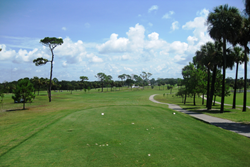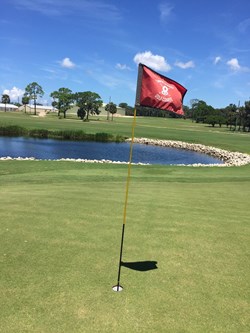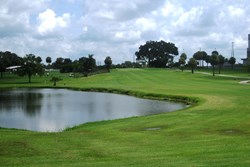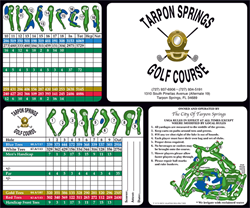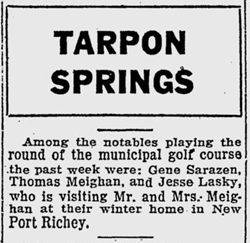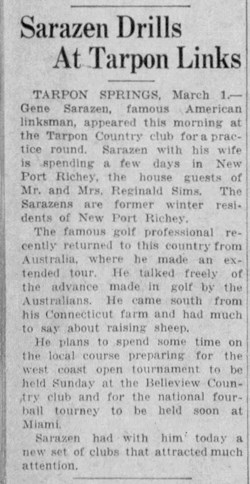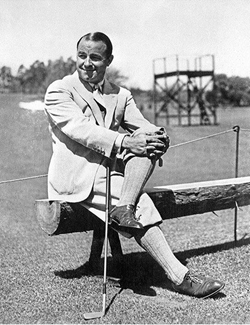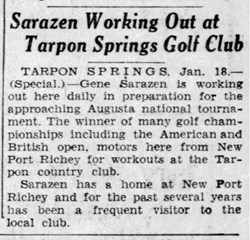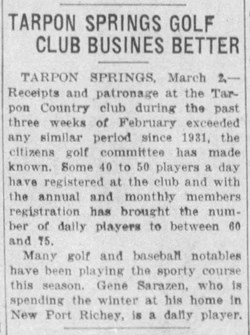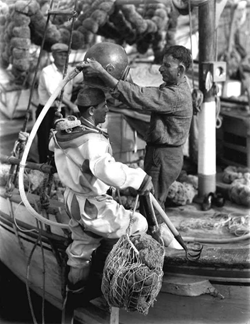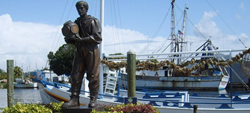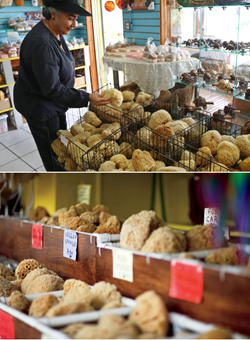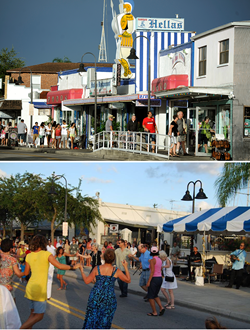Featured Golf Course
In this section learn more about the history of the course and its hometown, see a selection of historic and current images of the course, learn about what the course is like today, and discover nearby historic sites.
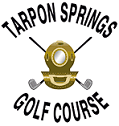
Tarpon Springs Golf Course
History
The Tarpon Springs Golf Course is located in the City of Tarpon Springs in Pinellas County. In 1912, a golf club was organized and golf links were soon under construction. By May, it was reported that a local builder, N. A. VanWinkle, had the contract for the golf course. Later that year the City hired William D. Leith, originally from Edinbourgh, Scotland, to supervise the work of putting the finishing touches on the golf course. Leith was the golf professional at the Northland Country Club in Duluth, Minnesota and a number of Duluth residents owned property in Tarpon Springs. Nine holes were in shape by the end of the year and Mr. Leith stated that “the local grounds will compare favorably with any in the country and will improve with age.”
In 1926, the City hired golf course architectural firm of Wayne Stiles & John R. Van Kleek to completely rebuild the existing 9-hole course and add nine more holes. At a cost of $17,600. the new 18-hole municipal golf course featured large greens, several ponds and a number of dog-leg holes. Golf legend Gene Sarazen had a home in nearby New Port Richey and was a regular player on the Tarpon Springs links in the 1930s. (see more information under the Local Knowledge section).
Golf course architect Mark Mahannah did some design work on the golf course in the late 1950s. On September 20, 2014, the City announced the grand reopening of its municipal golf course. The course had been closed for over a year for a complete renovation and reconstruction of all 18 greens plus two practice greens and other improvements. The new greens feature refreshed contours, Seashore paspalum grass, re-sanded bunkers and renovated tees. A year later, the driving range was renovated to offer more hitting areas on both grass and artificial turf.
Today
The 18-hole, par-72 Tarpon Springs Golf Course features four sets of tees playing from 4,800 to 6,000 yards and has Family Tees for beginners, juniors, and elderly players measuring 3400 yards. Tarpon Springs Golf Course prides itself in offering a fun, yet challenging course to players of all skill levels as well as top notch customer service to everyone who walks through the door. The course is owned and operated by the City of Tarpon Springs for the enjoyment of the public.
Local Knowledge
American golf legend Gene Sarazen built a winter home in nearby New Port Richey in the late 1920s and developed what would become the modern sand wedge [See full story in the Florida Historic Golf Trail publication pages 38 and 39].
Sarazen was a regular player on the Tarpon Springs links in the 1930s, including the year he won the Augusta National Invitational Tournament (Masters) in 1935. In that tournament, Sarazen hit "the shot heard round the world" making a double-eagle from 235 yards on the par-five 15th during the final round. Sarazen would go on to win a playoff with Craig Wood.
According to a Tampa Tribune article, Sarazen used the Tarpon Springs golf course to prepare for the 1936 Masters tournament. The newspaper article stated that Sarazen was working out at Tarpon Springs daily in preparation for the approaching Augusta national tournament. Sarazen would finish the tournament one under par to give him in 3rd place.
Inside the Leather
Historic Sponge Docks - The Gulf waters north of Tampa Bay comprise one of the few areas of the world where the species of natural sponges suitable for commercial use are found. Sponge beds were discovered off the mouth of the Anclote River by turtle fishermen from Key West in the late 1800s. Spongers came to the area to work the beds, and some relocated to Tarpon Springs. The natural sponge industry in Tarpon Springs dates from about 1890 when John K. Cheyney launched his first sponge-fishing boat. By 1900 the city was considered the largest sponge port in the United States. Sponges were retrieved by hooking until the technique of diving for sponges was introduced in 1905 by John Cocoris, a recent immigrant from Greece, where the practice of sponge diving was common. Within a few years, many Greeks had arrived in the area to work in the sponging industry.
In the summer of 2014, the Tarpon Springs Greektown Historic District was listed as a Traditional Cultural Property in the National Park Service’s National Register of Historic Places. The Tarpon Springs designation is Florida’s first recognized Traditional Cultural Property, and the first of its kind as a listed ethnic-based community in the United States.
Tourism has replaced sponging as Tarpon Springs’ major economic activity. Thousands of visitors each year come to the City to enjoy the outdoors, visit the Sponge Docks, see professional divers in action and experience the Greek culture that still permeates the City. Visitors come to walk Dodecanese Boulevard and visit its unique Greek shops, buy sponges and feast at restaurants serving traditional Greek fare and delectable pastries. Visit Sponge Docks for more details.
Visit - Contact
Tarpon Springs Golf Course
1310 South Pinellas Avenue
Tarpon Springs, Florida 34688
1310 South Pinellas Avenue
Tarpon Springs, Florida 34688
View the Website
Phone:
727.937.6906



